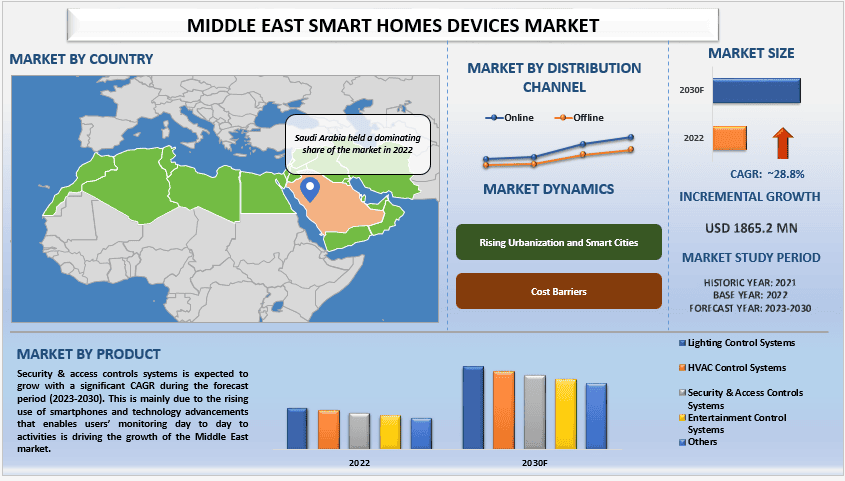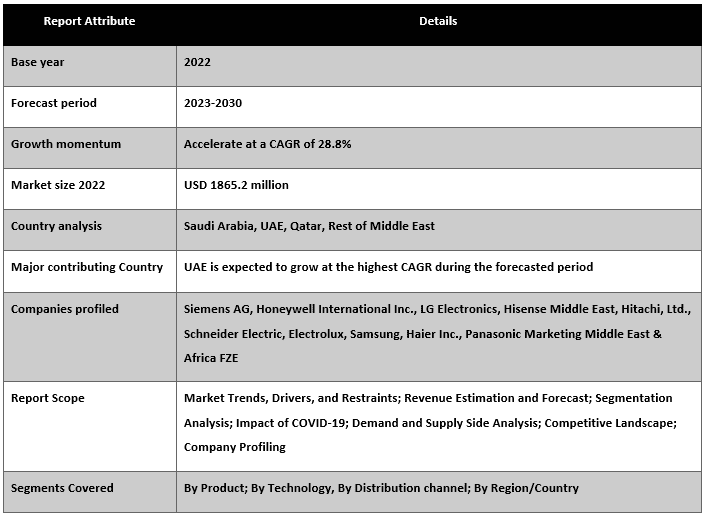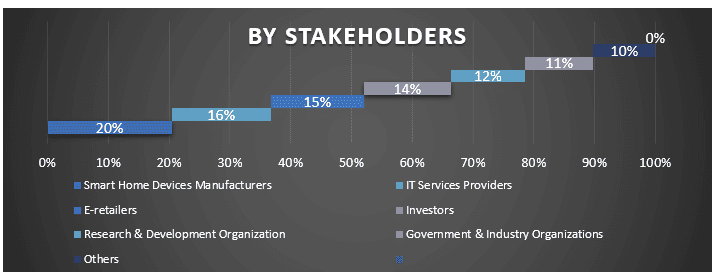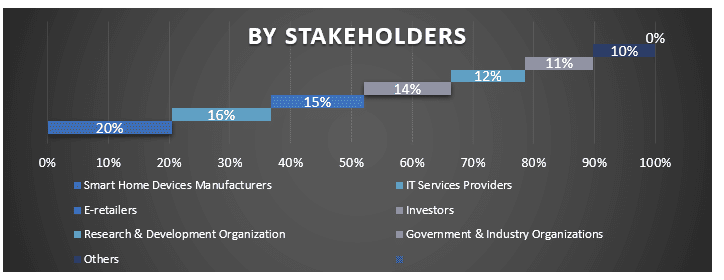Middle East Smart Homes Devices Market: Current Analysis and Forecast (2023-2030)
Emphasis on Product (Lighting Control Systems, HVAC Control Systems, Security & Access Controls Systems, Entertainment Control Systems, and Others); Technology (Wireless Communication, Cellular Network Technologies); and Distribution Channel (Online and Offline); Country
Geography:
Industry:
Last updated:
Dec 2023

The Middle East smart homes devices market was valued at USD 1865.2 Million in 2022 and is expected to grow at a strong CAGR of around 28.8% during the forecast period (2023-2030). The rise of the Internet of Things (IoT) is making it easier to connect and control home devices remotely in the Middle East region and the growth of urban areas is leading to higher adoption of smart devices due to convenience and space-saving features. As per the General Authority of Access, in 2023, almost 92% of Saudis have access to or own a smartphone. Android (53.87%) and iOS (46.01%) unsurprisingly accounted for virtually all the operating systems on smartphones across Saudi Arabia in 2022. Moreover, Government-led initiatives promoting smart city development in countries like the UAE and Saudi Arabia are significant drivers for the adoption of smart home devices. For instance, The Dubai 2040 Urban Master Plan is one such plan. It aims to encourage sustainable urban development in Dubai while also focusing on enhancing people’s happiness and quality of life.
Some of the major players operating in Siemens AG, Honeywell International Inc., LG Electronics, Hisense Middle East, Hitachi, Ltd., Schneider Electric, Electrolux, Samsung, Haier Inc., Panasonic Marketing Middle East & Africa FZE. Several M&As along with partnerships have been undertaken by these players to facilitate customers with hi-tech and innovative products/technologies.
Insights Presented in the Report
“Amongst products, the HVAC control systems segment is expected to grow with a significant CAGR during the forecast period (2023-2030).”
Based on the product, the market is segmented into lighting control systems, HVAC control systems, security & access controls systems, entertainment control systems, and others. HVAC control systems is expected to grow with a significant CAGR during the forecast period (2023-2030). The region experiences extreme temperatures, making efficient climate control essential. Smart thermostats and HVAC systems allow users to regulate their home’s temperature remotely, optimizing energy usage and enhancing comfort. Thus, the above factors drive the demand of smart home devices.
“Amongst distribution channel, offline held the largest share of the market in 2022.”
By distribution channel, the market is bifurcated into online and offline. The offline segment held a significant share of the market in 2022. This is mainly due to the offline channels providing a tactile experience and building trust among consumers. Moreover, significant purchases from stores with a physical presence, as they provide a sense of security and reliability drive the growth of the segment. Additionally, the trust factor associated with established offline retailers cannot be underestimated.
“Saudi Arabia dominated the market.”
The smart home devices industry in Saudi Arabia is held significant share of the market. In Saudi Arabia, there has been a concerted effort to embrace digital transformation and smart technologies. Saudi Arabia’s Vision 2030 acknowledges the significance of IoT and its potential to contribute to economic diversification, efficiency improvement, and the overall development of various sectors. Neom is one of the projects that is expected to drive the demand for IoT in the country. As part of this vision, there has been a strong focus on integrating smart solutions including smart home devices into daily life. The growing urbanization coupled with an increasing awareness of the benefits of home automation has fueled the demand for these devices in Saudi households. In 2022, 5G was available to 78% of the Saudi population, compared with 43% in 2020, as per the GSMA. Therefore, strategic initiatives and tech-friendly environment play pivotal roles in driving the widespread adoption of smart home technologies in the Middle East.
Middle East Smart Homes Devices Market Report Coverage

Reasons to buy this report:
- The study includes market sizing and forecasting analysis validated by authenticated key industry experts.
- The report presents a quick review of overall industry performance at one glance.
- The report covers an in-depth analysis of prominent industry peers with a primary focus on key business financials, product portfolios, expansion strategies, and recent developments.
- Detailed examination of drivers, restraints, key trends, and opportunities prevailing in the industry.
- The study comprehensively covers the market across different segments.
- Deep dive regional level analysis of the industry.
Customization Options:
The Middle East smart home devices market can further be customized as per the requirement or any other market segment. Besides this, UMI understands that you may have your own business needs, hence feel free to connect with us to get a report that completely suits your requirements.
Table of Contents
1. Market Introduction
- Market Definitions
- Main Objective
- Stakeholders
- Limitation
2. Research Methodology Or Assumptions
- Research Process of the Middle East Smart Homes Devices Market
- Research Methodology of the Middle East Smart Homes Devices Market
- Respondent Profile
3. Market Synopsis
- Market Synopsis
4. Executive Summary
- Executive Summary
5. Impact Of Covid-19 On The Middle East Smart Homes Devices Market
- Impact Of Covid-19 On The Middle East Smart Homes Devices Market
6. Middle East Smart Homes Devices Market Revenue, 2020-2030f
- Middle East Smart Homes Devices Market Revenue, 2020-2030f
7. Market Insights By Product
- Lighting Control Systems
- HVAC Control Systems
- Security & Access Controls Systems
- Entertainment Control Systems
- Others
8. Market Insights By Technology
- Wireless Communication
- Cellular Network Technologies
9. Market Insights By Distribution Channel
- Online
- Offline
10. Market Insights By Country
- UAE
- Saudi Arabia
- Qatar
- Kuwait
- Rest of Middle East
11. Middle East Smart Homes Devices Market Dynamics
- Market Drivers
- Market Challenges
- Impact Analysis
12. Middle East Smart Homes Devices Market Opportunities
- Middle East Smart Homes Devices Market Opportunities
13. Middle East Smart Homes Devices Market Trends
- Middle East Smart Homes Devices Market Trends
14. Demand And Supply-side Analysis
- Demand Side Analysis
- Supply Side Analysis
15. Value Chain Analysis
- Value Chain Analysis
16. Regulatory Framework In The Mena Region
- Regulatory Framework In The Mena Region
17. Pricing Analysis
- Pricing Analysis
18. Competitive Scenario
- Competitive Landscape
- Porters Fiver Forces Analysis
- Competitive Landscape
19. Company Profiled
- Siemens LLC
- Honeywell International Inc.
- LG Electronics
- Hisense Middle East
- Hitachi, Ltd.
- Schneider Electric
- Electrolux
- Samsung
- Haier Inc.
- Panasonic Marketing Middle East & Africa FZE
20. Disclaimer
- Disclaimer
Research Methodology for the Middle East Smart Homes Devices Market Analysis (2023-2030)
Analyzing the historical market, estimating the current market, and forecasting the future market of the Middle East Smart home devices market were the three major steps undertaken to create and analyze the adoption of Middle East Smart home devices in major countries. Exhaustive secondary research was conducted to collect the historical market numbers and estimate the current market size. Secondly, to validate these insights, numerous findings and assumptions were taken into consideration. Moreover, exhaustive primary interviews were also conducted, with industry experts across the value chain of the Middle East Smart home devices market. Post assumption and validation of market numbers through primary interviews, we employed a top-down/bottom-up approach to forecasting the complete market size. Thereafter, market breakdown and data triangulation methods were adopted to estimate and analyze the market size of segments and sub-segments of the industry pertains to. Detailed methodology is explained below:
Analysis of Historical Market Size
Step 1: In-Depth Study of Secondary Sources:
Detail secondary study was conducted to obtain the historical market size of the Middle East Smart home devices market through company internal sources such as annual reports & financial statements, performance presentations, press releases, etc., and external sources including journals, news & articles, government publications, competitor publications, sector reports, third-party database, and other credible publications.
Step 2: Market Segmentation:
After obtaining the historical market size of the Middle East Smart home devices market, we conducted a detailed secondary analysis to gather historical market insights and share for different segments & sub-segments for major regions. Major segments are included in the report as product, technology, and distribution channel. Further country-level analyses were conducted to evaluate the overall adoption of testing models in that region.
Step 3: Factor Analysis:
After acquiring the historical market size of different segments and sub-segments, we conducted a detailed factor analysis to estimate the current market size of the Middle East Smart home devices market. Further, we conducted factor analysis using dependent and independent variables such as product, technology, and distribution channel of the Middle East smart home devices market. A thorough analysis was conducted for demand and supply-side scenarios considering top partnerships, mergers and acquisitions, business expansion, and product launches in the Middle East Smart home devices market sector across the globe.
Current Market Size Estimate & Forecast
Current Market Sizing: Based on actionable insights from the above 3 steps, we arrived at the current market size, key players in the Middle East Smart home devices market, and market shares of the segments. All the required percentage shares split, and market breakdowns were determined using the above-mentioned secondary approach and were verified through primary interviews.
Estimation & Forecasting: For market estimation and forecast, weights were assigned to different factors including drivers & trends, restraints, and opportunities available for the stakeholders. After analyzing these factors, relevant forecasting techniques i.e., the top-down/bottom-up approach were applied to arrive at the market forecast for 2030 for different segments and sub-segments across the major markets. The research methodology adopted to estimate the market size encompasses:
- The industry’s market size, in terms of revenue (USD) and the adoption rate of the Middle East Smart home devices market across the major markets domestically
- All percentage shares, splits, and breakdowns of market segments and sub-segments
- Key players in the Middle East Smart home devices market in terms of products offered. Also, the growth strategies adopted by these players to compete in the fast-growing market
Market Size and Share Validation
Primary Research: In-depth interviews were conducted with the Key Opinion Leaders (KOLs) including Top Level Executives (CXO/VPs, Sales Head, Marketing Head, Operational Head, Regional Head, Country Head, etc.) across major regions. Primary research findings were then summarized, and statistical analysis was performed to prove the stated hypothesis. Inputs from primary research were consolidated with secondary findings, hence turning information into actionable insights.
Key Stakeholders of Smart home devices Market in the Middle East Region

Market Engineering
The data triangulation technique was employed to complete the overall market estimation and to arrive at precise statistical numbers for each segment and sub-segment of the Middle East Smart home devices market. The data was split into several segments & and sub-segments post studying various parameters and trends in the areas of the product, technology, and distribution channel of the Middle East Smart home devices market.
The main objective of the Middle East Smart home devices Market Study
The current & future market trends of the Middle East Smart home devices market were pinpointed in the study. Investors can gain strategic insights to base their discretion for investments on the qualitative and quantitative analysis performed in the study. Current and future market trends determined the overall attractiveness of the market at a regional and country level, providing a platform for the industrial participant to exploit the untapped market to benefit from a first-mover advantage. Other quantitative goals of the studies include:
- Analyze the current and forecast market size of the Middle East Smart home devices market in terms of value (USD). Also, analyze the current and forecast market size of different segments and sub-segments
- Segments in the study include areas of the product, technology, and distribution channel
- Define and analysis of the regulatory framework for the Middle East Smart home devices industry
- Analyze the value chain involved with the presence of various intermediaries, along with analyzing customer and competitor behaviors of the industry
- Analyze the current and forecast market size of the Middle East Smart home devices market for the major region
- Major countries of regions studied in the report include Saudi Arabia, UAE, Egypt, Iran, and the Rest of Middle East
- Company profiles of the Middle East Smart home devices market and the growth strategies adopted by the market players to sustain in the fast-growing market
- Deep dive regional level analysis of the industry

You can also purchase parts of this report. Do you want to check out a section wise
price list?
Frequently Asked Questions FAQs
Q1: What is the current market size and growth potential of the Middle East smart home devices market?
Q2: What are the driving factors for the growth of the Middle East smart home devices Market?
Q3: Which segment has the largest share of the Middle East smart home devices market by product?
Q4: What are the emerging technologies and trends in the Middle East smart home devices market?
Q5: Which country will dominate the Middle East smart home devices market?
Q6: Who are the key players operating in the Middle East smart home devices market?
Related Reports
Customers who bought this item also bought










